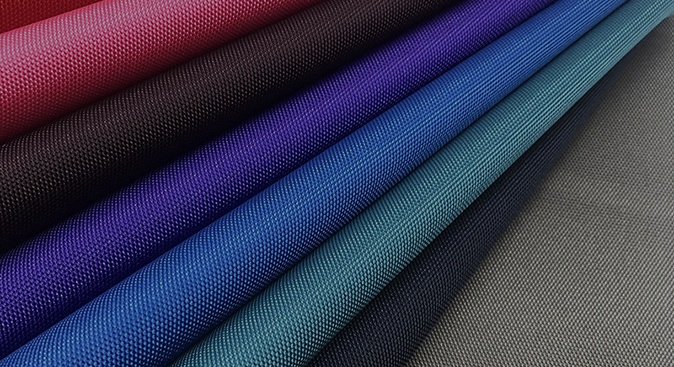1. Understanding PVC Coated Fabric
Define
PVC coated fabric is a versatile material widely used in the production of bags and luggage. Understanding its composition is crucial for bag manufacturers and fabric wholesalers. This blog post aims to provide a concise yet comprehensive overview of PVC coated fabric and its essential components.
PVC coated fabric refers to a textile material where a layer of polyvinyl chloride (PVC) is applied to one or both sides of the base fabric. This coating enhances the fabric’s durability, water resistance, and overall performance, making it ideal for various applications.
The base fabric, typically made from polyester, nylon, or cotton, serves as the foundation for PVC coated fabric. It provides strength, flexibility, and suitability for coating processes. The PVC layer, applied through methods like calendaring or lamination, offers excellent resistance to abrasion, chemicals, and UV radiation. It can be formulated with additives like plasticizers, stabilizers, pigments, and flame retardants to enhance specific properties such as flexibility, durability, color, and safety.
By understanding the composition of PVC coated fabric, bag manufacturers and fabric wholesalers can make informed decisions and create high-quality products. Its durable base fabric, PVC coating, and optional additives make it a reliable choice for producing bags and luggage that meet performance and aesthetic requirements. Stay tuned for more informative articles related to the bag manufacturing industry and fabric innovations.

Benefits
Coating fabric with PVC (Polyvinyl Chloride) is a widely employed technique in the production of high-quality bags and luggage. This process involves applying a layer of PVC onto the fabric surface, imparting a range of beneficial properties to the material.
The coating process begins with the preparation of the fabric, which is meticulously cleaned and treated to ensure optimal adhesion. Next, a specialized PVC formulation is applied to the fabric using various techniques such as dipping, spraying, or calendaring. The fabric is then subjected to controlled heat and pressure to facilitate the fusion of PVC with the textile fibers, resulting in a durable and versatile composite material.
Coating fabric with PVC offers several significant advantages. Firstly, it enhances the fabric’s resistance to water, making it impermeable to liquids and providing superior protection against moisture. This characteristic makes PVC-coated fabric ideal for manufacturing bags and luggage, as it ensures the contents remain dry even in adverse weather conditions.
Moreover, the PVC coating reinforces the fabric’s durability, enhancing its resistance to wear, tear, and abrasion. This property significantly extends the lifespan of bags and luggage, making them suitable for rigorous daily use. Additionally, PVC-coated fabric exhibits excellent color retention, preserving the vibrant and appealing appearance of the products over time.
Furthermore, PVC-coated fabric possesses inherent strength and stability, allowing it to maintain its shape and structure. This enables the creation of well-defined and intricate designs, ensuring the final products retain their form even when subjected to heavy loads or stress.

2. Waterproof Performance of PVC Coated Fabric
Inherent Water Resistance
PVC coated fabric, widely used in the manufacturing of bags and luggage, possesses inherent water resistance owing to its unique composition. Understanding the factors contributing to this characteristic is crucial for bag manufacturers and fabric wholesalers. In this blog, we delve into the composition of PVC coated fabric and elucidate its inherent water resistance.
PVC coated fabric derives its water-resistant properties from a combination of factors, primarily its composition. The fabric consists of a base material, typically woven polyester or nylon, which is coated with a layer of polyvinyl chloride (PVC) resin. This PVC coating imparts several beneficial attributes to the fabric, including water resistance.
The hydrophobic nature of PVC plays a pivotal role in conferring water resistance. PVC, being a thermoplastic polymer, repels water due to its non-polar chemical structure. The absence of polar groups within the PVC molecule prevents water molecules from adhering to the fabric’s surface, resulting in its resistance to water penetration.
Additionally, the process of coating the base material with PVC involves the application of heat and pressure. This fusion of PVC resin onto the fabric creates a seamless, impermeable layer that further enhances water resistance. The tightly bonded PVC coating forms a barrier, preventing water molecules from seeping through the fabric’s surface.

Barrier Against Moisture Penetration
PVC coating is a crucial technique in bag manufacturing, creating a robust barrier against moisture penetration. This process involves applying a layer of PVC to the fabric, effectively preventing water molecules from seeping through. In addition to moisture resistance, PVC coating enhances fabric durability, providing resistance to stains, dirt, and mildew. This versatile technique is widely used in various applications of backpacks, travel bags, and protective covers. Bag factories and fabric wholesalers can leverage PVC coating to produce long-lasting, moisture-resistant products, meeting customer demands and ensuring success in the competitive industry.
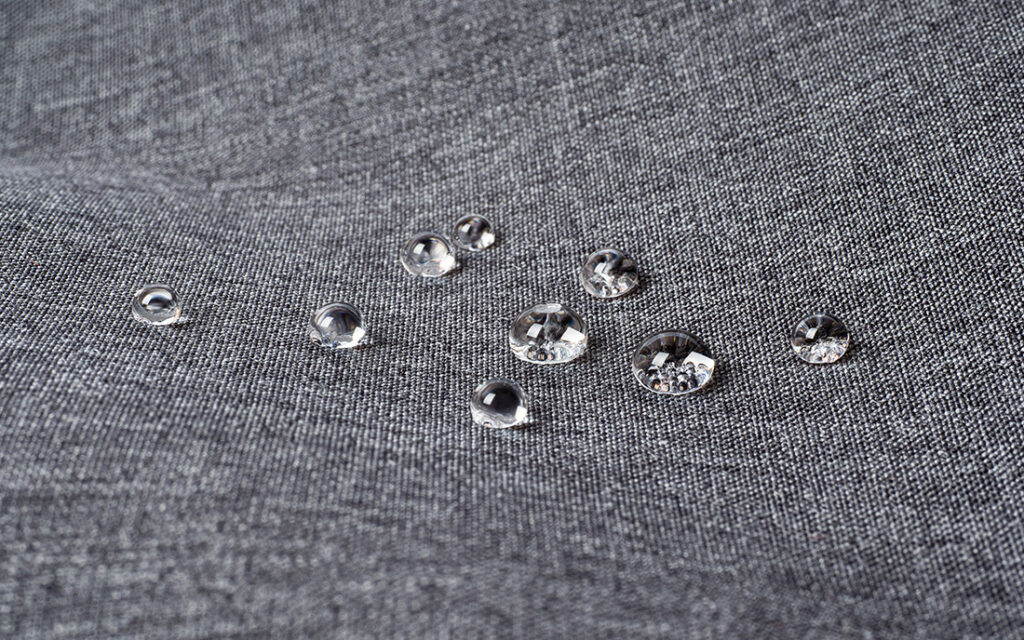
Advantages Over Other Types
PVC coated fabric provides exceptional advantages in terms of waterproofing for bag manufacturing. Its robust PVC coating acts as a barrier against moisture, protecting the contents of bags from rain or liquid exposure. Unlike other fabrics, PVC coated fabric maintains its lightweight and flexibility when wet, ensuring comfort for bag users. Additionally, its durability extends the lifespan of bags by protecting against wear and tear. With a wide range of design options available, bag manufacturers can create visually appealing products. Overall, PVC coated fabric is a preferred choice, offering superior waterproofing capabilities and contributing to the production of high-quality, functional, and visually appealing bags.
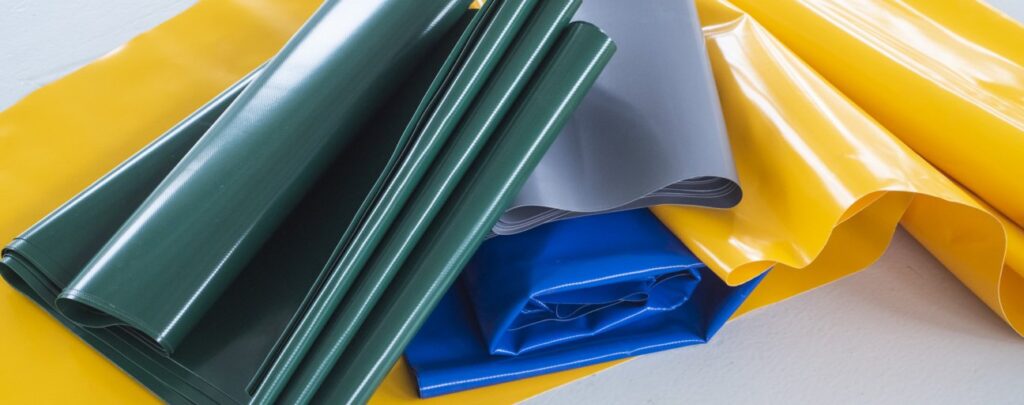
3. Testing and Standards for Waterproof PVC Coated Fabric
Industry Standards and Testing Methods
Industry Standards: Various industry standards govern the evaluation of waterproofing capabilities in PVC coated fabrics. Notable standards include ISO 1421:2016 and ISO 811:2018. ISO 1421:2016 assesses the resistance of fabrics to water penetration through a hydrostatic pressure test, while ISO 811:2018 measures the fabric’s ability to resist water penetration under constant or intermittent pressure.
Testing Methods: To determine the waterproof properties of PVC coated fabrics, several testing methods are commonly employed. The hydrostatic head test measures the pressure water requires to penetrate the fabric. This evaluates the fabric’s water resistance under static conditions. Additionally, the spray test assesses the material’s resistance to water penetration when subjected to a continuous or intermittent spray of water. Another method, the rain test, simulates real-life scenarios by evaluating the fabric’s performance under heavy rainfall.

Explanation of Key Tests
When it comes to the production of bag fabrics, understanding key tests is crucial for bag manufacturers and fabric wholesalers. The hydrostatic pressure resistance test determines a fabric’s ability to withstand water under pressure, ensuring durability in adverse weather conditions. The water column test assesses a fabric’s resistance to water penetration, helping make informed decisions about its suitability for various bag designs. The spray rating test evaluates a fabric’s resistance to water splashes and spills. By comprehending these tests, manufacturers can ensure fabrics meet required standards, and wholesalers can recommend high-quality materials for bag production. Prioritizing the quality and performance of bag fabrics will result in durable and reliable products that exceed customer expectations.

Certifications and Standards
In the highly competitive world of bag fabric manufacturing, ensuring quality and performance is of utmost importance. As a reputable producer in this industry, we understand the significance of adhering to relevant certifications and standards. By aligning our processes with internationally recognized benchmarks, such as ISO (International Organization for Standardization), ASTM (American Society for Testing and Materials), and specific regional standards, we guarantee the delivery of top-notch products to our valued clients, including bag factories and fabric wholesalers.
ISO standards are globally acknowledged and cover various aspects of quality management, production processes, and environmental responsibility. Implementing ISO certifications, such as ISO 9001 for quality management systems and ISO 14001 for environmental management, demonstrates our commitment to excellence and sustainability throughout the manufacturing journey.
ASTM standards, developed by experts in the industry, provide comprehensive guidelines for testing and evaluating fabric properties. These standards help us assess critical factors such as tensile strength, tear resistance, colorfastness, and abrasion resistance. By complying with ASTM standards, we ensure that our bag fabrics exhibit exceptional durability and meet or exceed customer expectations.
Furthermore, we stay updated on specific regional standards, which may vary from country to country. Whether it’s complying with European Union regulations on chemical usage or meeting the requirements set by the Consumer Product Safety Commission in the United States, we remain diligent in following these standards to guarantee the safety, reliability, and compliance of our bag fabrics in various markets.
By highlighting our adherence to certifications and standards like ISO, ASTM, and regional benchmarks, we instill confidence in our clients, assuring them of the superior quality and performance of our bag fabrics. At our factory, we continuously strive to raise the bar, combining technical expertise, rigorous testing, and a commitment to excellence, all aimed at delivering exceptional products that meet the ever-evolving demands of the bag manufacturing industry.
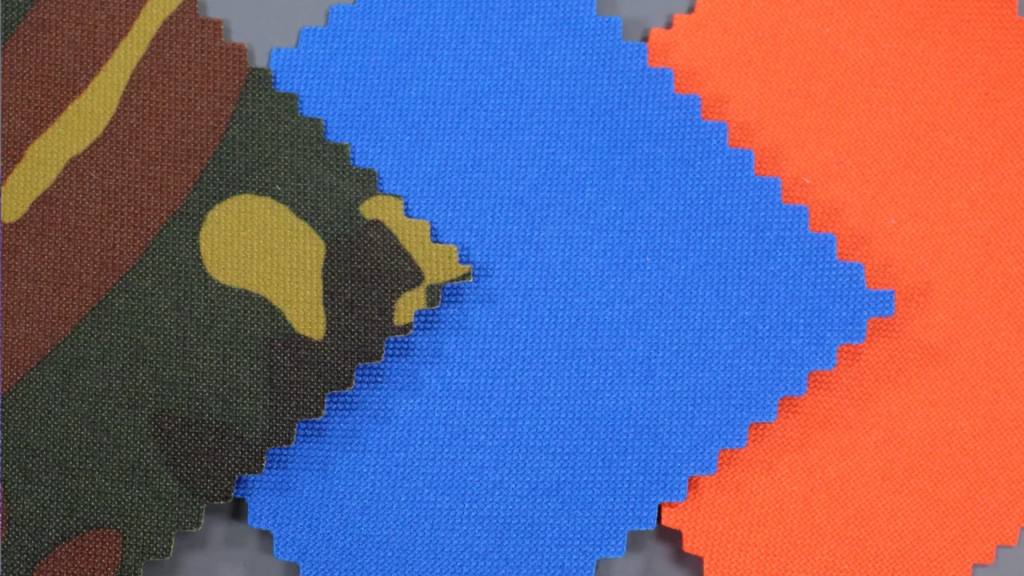
4.Benefits for Luggage Factories and Fabric Distributors
Durability and Longevity
Durability is crucial for bag factories and fabric wholesalers. PVC coated fabrics excel in this aspect, offering exceptional strength, tear resistance, and puncture protection. They also provide excellent water resistance, keeping contents dry. Moreover, PVC coated fabrics are easy to clean and maintain, ensuring long-lasting visual appeal. By utilizing these fabrics, bag factories can create reliable and aesthetically pleasing bags, while fabric wholesalers can offer customers a wide range of durable options. PVC coated fabrics are a valuable asset, enabling businesses to thrive in the competitive market.
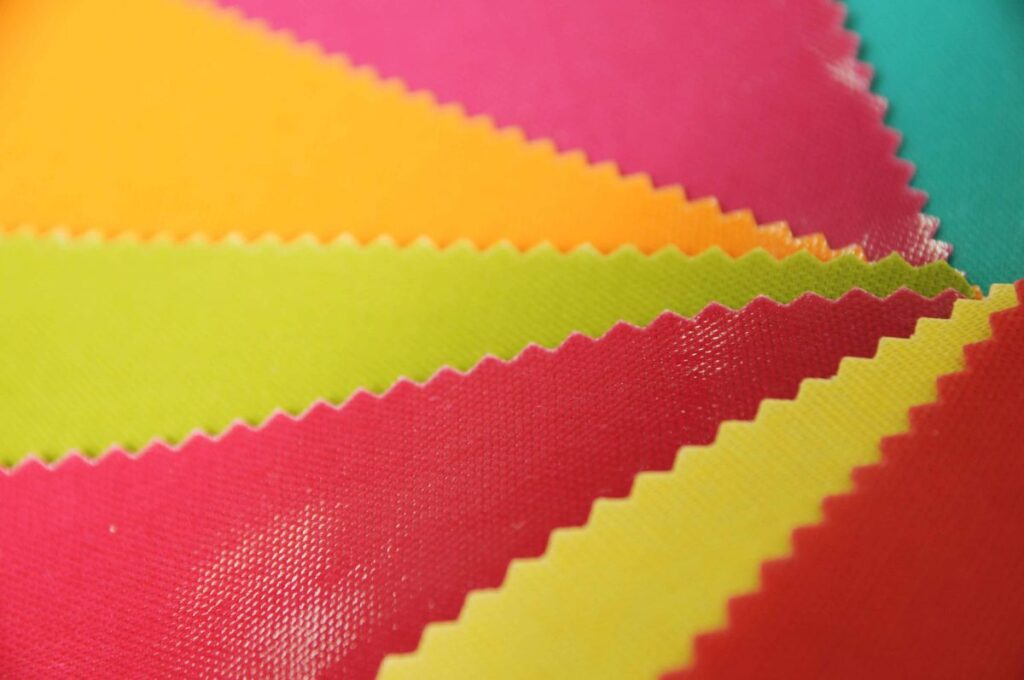
Water Resistance and Moisture Protection
The benefits of water resistance and moisture protection provided by PVC coated fabrics are invaluable for bag factories and fabric wholesalers. Firstly, the enhanced durability offered by PVC coated fabrics is a significant advantage. These fabrics effectively repel water, preventing moisture from seeping through and safeguarding the contents of the bags from rain, spills, and other external elements. By incorporating PVC coated fabrics into their production process, bag factories can significantly increase the lifespan and reliability of their bags, providing customers with long-lasting and dependable solutions.
Secondly, the versatility of PVC coated fabrics is worth noting. Their water resistance and moisture protection properties make them suitable for a wide range of applications. Bag factories and fabric wholesalers can offer products that are suitable for outdoor activities, travel, and everyday use. PVC coated fabrics are resilient and can withstand diverse weather conditions, making them an ideal choice for manufacturing bags that can endure the rigors of daily life. Additionally, fabric wholesalers can cater to various industries by supplying PVC coated fabrics for different bag designs and purposes.
Lastly, the use of PVC coated fabrics leads to increased customer satisfaction. By incorporating these fabrics into their bags, factories can deliver products that offer enhanced water resistance, minimizing the risk of damage to belongings. This feature resonates with customers who value functionality and reliability in their bags. Fabric wholesalers, in turn, can provide a sought-after material that meets the demands of bag manufacturers seeking durable and versatile fabrics. Satisfied customers are more likely to return for future purchases and spread positive word-of-mouth, benefiting both bag factories and fabric wholesalers.

Easy Maintenance and Cleanliness
PVC coated fabrics offer bag factories and fabric wholesalers numerous benefits in terms of easy maintenance and cleanliness. These fabrics are highly resistant to stains, spills, and dirt accumulation, simplifying the cleaning process and saving time and effort. They also exhibit water-resistant properties, ensuring bags can withstand various weather conditions and protect their contents from moisture damage. With low maintenance requirements, PVC coated fabrics can be easily cleaned using mild soap and water, offering cost-effective and efficient cleaning solutions. Lastly, their durability adds value to bags, prolonging their lifespan and contributing to sustainability efforts in the industry.

Versatility and Design Options
PVC coated fabrics provide bag factories and fabric wholesalers with a wide range of design options. These fabrics can be manufactured in numerous colors, patterns, and textures, allowing bag manufacturers to create bags that are visually appealing and on-trend. The ability to customize PVC coated fabrics enables bag factories to differentiate their products and meet the specific design requirements of their customers. Fabric wholesalers can also benefit from the diverse design options of PVC coated fabrics by offering a variety of choices to their clients, thereby expanding their customer base. Whether it’s vibrant colors, sleek metallic finishes, or textured surfaces, PVC coated fabrics provide endless design possibilities for bag factories and fabric wholesalers alike.

5. How to choose waterproof pvc coated fabric
Durability and Strength
When it comes to manufacturing bags, durability, and strength are key considerations. Waterproof PVC coated fabric stands out as an excellent choice due to its moisture resistance and enhanced durability. The PVC coating acts as a protective layer, preventing water penetration and safeguarding the bag’s contents. Additionally, the fabric’s strength ensures it can withstand abrasions, tears, and general wear and tear, resulting in long-lasting products. Moreover, the fabric’s strength contributes to the bag’s structural integrity, allowing it to maintain its shape even under heavy loads. By selecting waterproof PVC coated fabric, bag manufacturers and fabric wholesalers can provide customers with high-quality, reliable products that meet their expectations for durability and strength.

Testing and Certification
Choosing the right waterproof PVC coated fabric is crucial for bag manufacturers and fabric wholesalers. Rigorous testing is essential to evaluate water resistance, durability, and performance. Tests like hydrostatic pressure, seam strength, and abrasion resistance provide valuable insights. Additionally, certifications such as ISO 9001:2015, ISO 9001:2018, and ISO 14001:2015 ensure adherence to quality control, sustainability, and product performance standards. Opting for tested and certified fabric offers consistent quality, boosts brand reputation, and promotes environmental responsibility. Prioritizing testing and certification enables bag manufacturers and fabric wholesalers to deliver high-quality products while emphasizing customer satisfaction and sustainability.

Supplier Selection
Supplier selection for waterproof PVC coated fabric is crucial for bag manufacturers and fabric wholesalers. Consider factors like quality standards, material sourcing, customization options, production capacity, and reputation. Choose a supplier that adheres to industry requirements, sources high-grade materials, offers tailored solutions, can meet demand volume, and has a positive reputation. By making an informed decision, you can ensure the production of high-quality bags that satisfy customer needs.
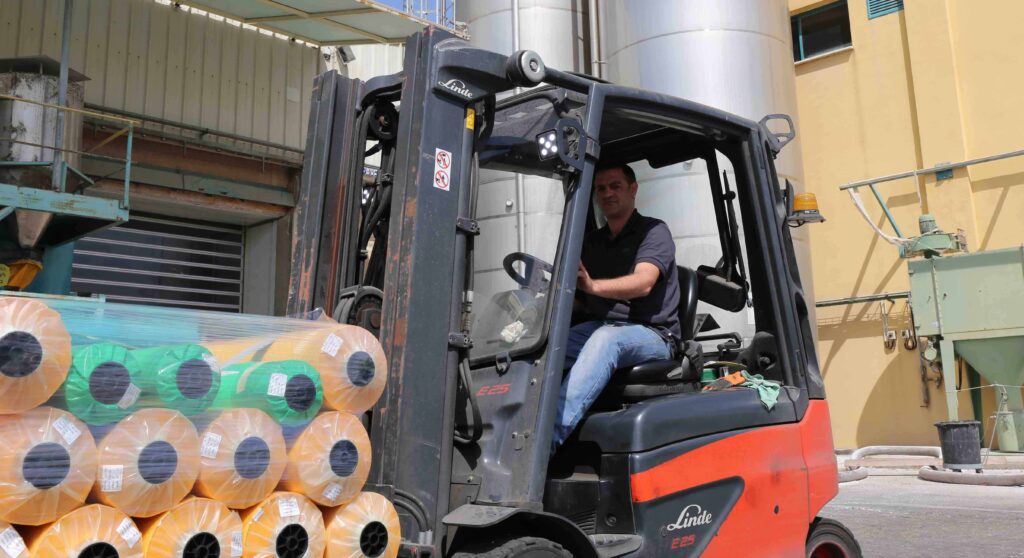
6. Quality Control Measures
Raw Material Inspection
The inspection of PVC coated fabric is a crucial step in our manufacturing process. We meticulously evaluate the fabric’s composition, including the base material and its weight, thickness, and density. Our focus then shifts to the coating, examining its thickness, adhesion, and uniformity. We conduct rigorous tests for colorfastness and physical properties, assessing resistance to wear, tear, stretching, and color fading. By adhering to stringent inspection standards, we ensure that our PVC coated fabric meets the highest quality criteria. Bag manufacturers and fabric wholesalers can trust in our commitment to excellence, knowing they will receive top-notch materials for creating durable and visually appealing luggage and bags.

Coating Thickness Measurement
Coating thickness measurement is critical for evaluating the performance and longevity of PVC coated fabrics. Precise measurement techniques such as magnetic induction or eddy current methods enable manufacturers to determine the PVC layer’s thickness accurately. This data-driven approach ensures consistent quality control, optimal production processes, and products that meet or exceed customer expectations. Stay tuned for more insightful articles on bag and luggage fabric production as we continue exploring this dynamic industry.

Abrasion Resistance Testing
Abrasion resistance is vital for bag fabrics, especially those with PVC coating, as they must endure daily wear, travel, and environmental conditions. To ensure our fabrics exceed industry standards, we subject them to rigorous testing. Samples of our PVC coated fabrics undergo controlled rubbing against an abrasive surface, simulating real-world wear and tear scenarios. This testing helps us determine the fabric’s resistance to abrasion and predict its long-term durability.
By consistently enhancing our fabrics’ abrasion resistance, we offer bag factories and fabric wholesalers reliable and long-lasting materials for their manufacturing needs. Choosing materials with excellent abrasion resistance is crucial in bag production. Contact us today to explore our range of PVC coated fabrics that excel in abrasion resistance testing.

7.Conclusion
In conclusion, when considering the question “Is PVC Coated Fabric Waterproof?”, it is evident that PVC coated fabric offers a high level of water resistance, making it a desirable choice for manufacturers in the bag and luggage industry, as well as fabric wholesalers. The PVC coating, applied to various substrates such as nylon or polyester, forms a protective layer that effectively repels water and prevents it from permeating the fabric. This characteristic is crucial for bag manufacturers as it ensures the safety and protection of valuable contents, especially during adverse weather conditions or in damp environments.
The waterproofing properties of PVC coated fabric are further enhanced by its seam-sealing capabilities, which help to prevent water penetration through stitched areas. This ensures that the final product maintains its water-resistant properties even in areas where multiple pieces of fabric are joined together.
Furthermore, PVC coated fabric exhibits durability, flexibility, and resistance to abrasion, making it a reliable choice for manufacturers seeking long-lasting and reliable materials for their products. Its versatility allows for a wide range of design options, making it suitable for various bag styles and purposes.
By understanding the waterproof nature of PVC coated fabric and its suitability for bag and luggage manufacturing, bag factories and fabric wholesalers can make informed decisions when selecting materials. Ultimately, PVC coated fabric emerges as a dependable choice that meets the needs of both bag manufacturers and fabric wholesalers in terms of water resistance, durability, and design possibilities.



